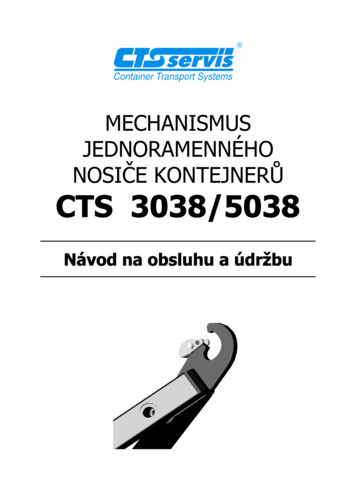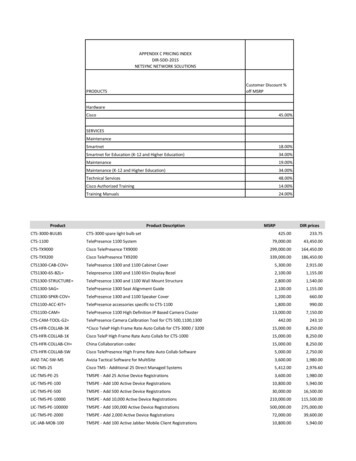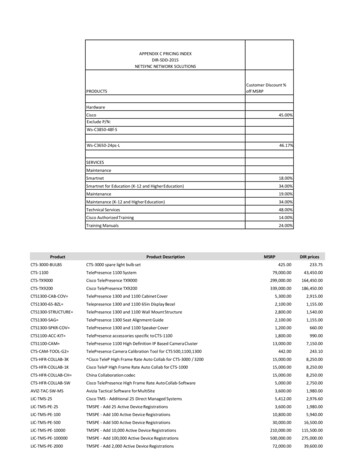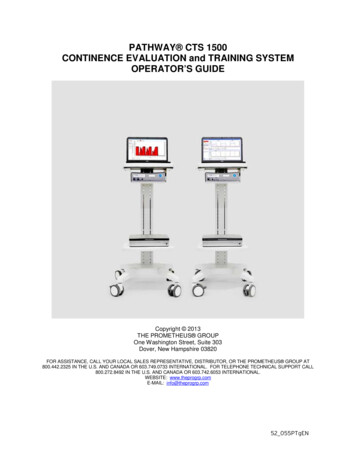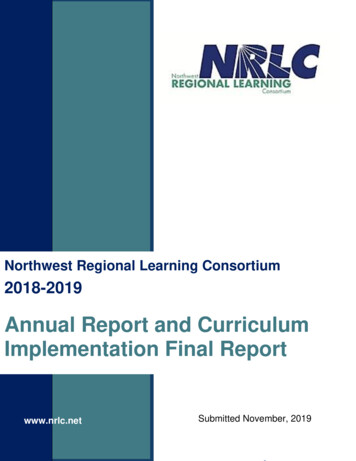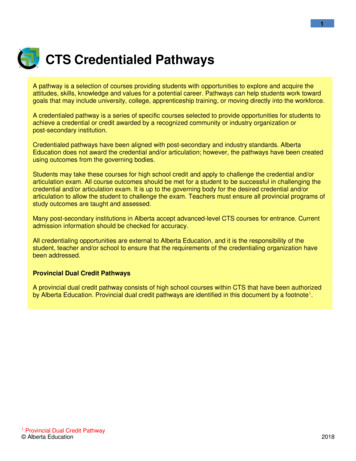
Transcription
1CTS Credentialed PathwaysA pathway is a selection of courses providing students with opportunities to explore and acquire theattitudes, skills, knowledge and values for a potential career. Pathways can help students work towardgoals that may include university, college, apprenticeship training, or moving directly into the workforce.A credentialed pathway is a series of specific courses selected to provide opportunities for students toachieve a credential or credit awarded by a recognized community or industry organization orpost-secondary institution.Credentialed pathways have been aligned with post-secondary and industry standards. AlbertaEducation does not award the credential and/or articulation; however, the pathways have been createdusing outcomes from the governing bodies.Students may take these courses for high school credit and apply to challenge the credential and/orarticulation exam. All course outcomes should be met for a student to be successful in challenging thecredential and/or articulation exam. It is up to the governing body for the desired credential and/orarticulation to allow the student to challenge the exam. Teachers must ensure all provincial programs ofstudy outcomes are taught and assessed.Many post-secondary institutions in Alberta accept advanced-level CTS courses for entrance. Currentadmission information should be checked for accuracy.All credentialing opportunities are external to Alberta Education, and it is the responsibility of thestudent, teacher and/or school to ensure that the requirements of the credentialing organization havebeen addressed.Provincial Dual Credit PathwaysA provincial dual credit pathway consists of high school courses within CTS that have been authorizedby Alberta Education. Provincial dual credit pathways are identified in this document by a footnote1.1Provincial Dual Credit Pathway Alberta Education2018
2Pathway MenuSelect a credentialed pathway listed below to see the courses required and/or recommended to complete thatparticular pathway. Pathways are listed in alphabetical order under one of five CTS clusters or ApprenticeshipPathways.Business, Administration, Finance & Information Technology (BIT) Credentialed PathwaysCisco Certified Entry Networking Technician (CCENT)CompTIA A CompTIA Network Computer ScienceFocus on Information Technology (FIT)Microsoft Office Specialist (MOS) in Microsoft Office AccessMicrosoft Office Specialist (MOS) in Microsoft Office ExcelMicrosoft Office Specialist (MOS) in Microsoft Office PowerPointMicrosoft Office Specialist (MOS) in Microsoft Office WordMicrosoft Technology Associate (MTA) in Networking FundamentalsMicrosoft Technology Associate (MTA) in Windows Operating System FundamentalsOffice Administration Professional1Health, Recreation & Human Services (HRH) Credentialed PathwaysAthletic Injury ManagementCanadian Academy of Travel and Tourism (CATT) Level ICanadian Academy of Travel and Tourism (CATT) Level IICertified Coach – National Coaching Certification Program (NCCP)Child Development AssistantCriminal Justice Studies1emerit Food and Beverage ServerFirst Aid in Child CareFood Safety CertificationFoundations of Athletic TherapyFoundations of MentoringGroup Exercise Leader – Aquatic ExerciseGroup Exercise Leader – Fitness for the Older AdultGroup Exercise Leader – Group ExerciseGroup Exercise Leader – Resistance TrainingHealth Care Aide 1Leave No Trace TrainerMedical First ResponderPhysical Education and RecreationSport Nutrition Level 1Sport Taping and StrappingStandard First Aid with CPR (Level C) and AED1Provincial Dual Credit Pathway Alberta Education2018
3Media, Design & Communication Arts (MDC) Credentialed PathwaysAdobe Certified Associate (ACA) in Visual Communication using Adobe PhotoshopAdobe Certified Associate (ACA) in Rich Media Communication using Adobe Flash ProfessionalAdobe Certified Associate (ACA) in Web Communication using Adobe DreamweaverAdobe Certified Associate (ACA) in Video Communication using Adobe Premiere ProAdvanced Stitcher Sewing AssessmentEntry Level Stitching AssessmentNatural Resources (NAT) Credentialed PathwaysAlberta Conservation and Hunter Education ProgramAlberta Fishing Education ProgramInternational Bowhunter Education ProgramPleasure Craft Operator CardTrades, Manufacturing & Transportation (TMT) Credentialed PathwaysPower Engineering (5th Class)1Power Engineering (4th Class)11Provincial Dual Credit Pathway Alberta Education2018
4Apprenticeship PathwaysHigh school students in Alberta who successfully complete all courses in a Career and TechnologyStudies (CTS) Apprenticeship Pathway, as approved by the Provincial Apprenticeship Committeepursuant to the Apprenticeship and Industry Training Act, are eligible to write the Apprenticeship andIndustry Training exam for advanced standing in the first period of technical training for that trade.The requirements for program recognition and advanced standing must be followed as outlined byAlberta Apprenticeship and Industry Training. For more information, visit Tradesecrets: Career andTechnology Studies (CTS) Apprenticeship Pathways. Recognition of a CTS Apprenticeship Pathway is available for the first period of technical trainingonly. The Hairstylist Apprenticeship Pathway is the only apprenticeship pathway that includes thesecond period of training. Students are granted advanced standing for technical training towards an apprenticeship programupono successful completion of the Apprenticeship and Industry Training exam, with a minimum markof 70% (theory exam or theory and practical exam, depending on the trade)o registering into a contract of apprenticeship The CTS Apprenticeship Pathway must be taught in an Alberta Education-approved facility. Thefacility is the responsibility of the school authority and must be equipped to industry standards todeliver the CTS Apprenticeship Pathway. (Apprenticeship and Industry Training does not inspect orapprove facilities for the delivery of K-12 programs.) All required courses in a CTS Apprenticeship Pathway must be instructed by a journeyperson for thattrade (i.e., an individual holding a trade certificate recognized in Alberta).For trades supported by Individual Learning Modules (ILMs), the ILMs must be utilized as a primaryresource for the delivery of instruction. All students must have access to their own ILMs. Copies of theILMs are available to teachers by login through LearnAlberta. For trades where ILMs have not beendeveloped, please refer to the books and materials listed at Tradesecrets: Trades & Occupations List.Students must successfully complete all courses in a CTS Apprenticeship Pathway as listed on the CTSCourse Completion Record to be eligible to write the Apprenticeship and Industry Training exam. A CTSCourse Completion Record is available at Tradesecrets: Forms and References for each recognizedCTS Apprenticeship Pathway.Following high school completion, a student can register as an apprentice by obtaining employment witha sponsor of apprenticeship and signing a contract of apprenticeship with the employer andApprenticeship and Industry Training. The student must meet the entrance requirements for the trade.For complete information, visit Apprenticeship and Industry Training: Tradesecrets.Agricultural Equipment Technician1Auto Body Technician1Automotive Service ion Technician1Cook1Electrician1Hairstylist1Heavy Equipment Technician1Industrial Mechanic (Millwright)1Instrumentation and Control Technician1Insulator1Landscape Horticulturist1Painter and Decorator1Parts Technician1Plumber1Welder11Provincial Dual Credit Pathway Alberta Education2018
5Credentialed Pathways DescriptionsBusiness, Administration, Finance & Information Technology (BIT) CredentialedPathwaysCisco Certified Entry Networking Technician (CCENT)NET2030: Network StructuresNET2040: Network Media & DevicesNET2050: Open System InterconnectionNET2060: Network ProtocolsNET2070: Local Area NetworksNET3050: Network Operating SystemsNET3060: Wide Area NetworksNET3070: Routing FundamentalsNET3080: Internet ProcessesNET3090: Network ManagementNET3100: Network Media & Devices, SecurityCisco Certified Entry Networking Technician (CCENT) validates the ability to install, operate, and troubleshoota small enterprise branch network, including basic network security. With a CCENT, a network professionaldemonstrates the skills required for entry-level network support positions, the starting point for manysuccessful careers in networking. The exam tests for knowledge and skills related to networking fundamentals,LAN switching technologies, routing technologies, infrastructure services, and infrastructure maintenance.Students may take these courses for high school credit only and/or may choose to write the externalcertification exams (100–105 ICND1) at a local testing centre.For more information, visit Cisco: Training & Certifications.Return to TopCompTIA A NET2020: Workstation Technology & OperationsNET2030: Network StructuresNET2080: Laptops & PeripheralsNET3100: Network Media & Devices, SecurityCompTIA A certification validates the latest skills needed by today’s computer support professionals. It is aninternational, vendor-neutral certification recognized by major hardware and software vendors, distributors andresellers. CompTIA A confirms a technician’s ability to perform tasks such as installation, configuration,diagnosing, preventive maintenance, and basic networking. The exams also cover topics such as security,networking, operating systems, IT Operations, troubleshooting, and technical support.Students may take these courses for high school credit only and/or may choose to write the externalcertification at a local testing centre.For more information, visit CompTIA.Return to Top Alberta Education2018
6CompTIA Network NET2030: Network StructuresNET2040: Network Media & DevicesNET2050: Open System InterconnectionNET2060: Network ProtocolsNET2070: Local Area NetworksNET3050: Network Operating SystemsNET3060: Wide Area NetworksNET3070: Routing FundamentalsNET3080: Internet ProcessesNET3090: Network ManagementCompTIA Network validates the knowledge and skills of networking professionals. It is an international,vendor-neutral certification that recognizes a technician’s ability to describe the features and functions ofnetworking components and to install, configure, and troubleshoot basic networking hardware, protocols, andservices. Although not a prerequisite, it is recommended that CompTIA Network candidates have at leastnine months of experience in network support or administration, or adequate academic training, along withCompTIA A certification.Students may take these courses for high school credit only and/or may choose to write the externalcertification at a local testing centre.For more information, visit CompTIA.Return to TopComputer ScienceCSE3010: Computer Science 3CSE3020: Computer Science 4CSE3110: Iterative Algorithm 1CSE3120: Object-oriented Programming 1CSE3130: Object-oriented Programming 2CSE3140: Second Language Programming 2CSE3210: Server-side Scripting 1CSE3240: Robotics Programming 3CSE3310: Recursive Algorithms 1CSE3320: Dynamic Data Structures 1CSE3330: Dynamic Data Structures 2CSE3340: Dynamic Data Structures 3CSE3910: CSE Project DCSE3920: CSE Project ECSE3950: CSE Advanced PracticumFive advanced level (3000) Computer Science (CSE) courses can be used to meet entrance requirements atmany universities and colleges in Alberta. Refer to the general admission requirements for individualpost-secondary institutions for more information.Return to TopFocus on Information Technology (FIT)NET1010: Digital Technology 1NET2020: Workstation Technology & OperationsNET2080: Laptops & PeripheralsNET2110: Telecommunications 1NET3100: Network Media & Devices, SecurityThe Focus on Information Technology (FIT) program was designed to prepare students for a world that runs oncomputers. It provides high school students with technology skills, business skills, and essential workplaceskills and experience. Students will receive a national certification from the federal government and theInformation and Communication Technology Council of Canada upon the successful completion of theidentified CTS courses. Students are also encouraged to prepare for industry recognized credentials such asA , Java, Cisco, Adobe, and/or Microsoft certifications.For more information, visit Information and Communications Technology Council.Return to Top Alberta Education2018
7Microsoft Office Specialist (MOS) in Microsoft Office AccessINF1050: Database 1INF2070: Database 2To earn the Microsoft Office Specialist (MOS) certification for Microsoft Office Access, students must pass thecertification exam for the version in which they have completed their training (i.e., 2007, 2010, 2013, or 2016).Microsoft Office Specialist exams provide a valid and reliable measure of technical proficiency and expertise byevaluating students’ overall comprehension of Office programs, their ability to use the advanced features ofthese programs, and their ability to integrate the Office programs with other software programs.Students can take these courses and receive only high school credit and/or may choose to write the externalcertification exam at a testing centre near them. MOS testing centres can be found by using the locator atCertiport Authorized Testing Center.For more information, visit Microsoft Computer Training.Return to TopMicrosoft Office Specialist (MOS) in Microsoft Office ExcelINF1060: Spreadsheet 1INF2080: Spreadsheet 2To earn the Microsoft Office Specialist (MOS) certification for Microsoft Office Excel, students must pass thecertification exam for the version in which they have completed their training (i.e., 2007, 2010, 2013, or 2016).Microsoft Office Specialist exams provide a valid and reliable measure of technical proficiency and expertise byevaluating students’ overall comprehension of Office programs, their ability to use the advanced features ofthese programs, and their ability to integrate the Office programs with other software programs.Students can take these courses and receive only high school credit and/or may choose to write the externalcertification exam at a testing centre near them. MOS testing centres can be found by using the locator atCertiport Authorized Testing Center.For more information, visit Microsoft Computer Training.Return to Top Alberta Education2018
8Microsoft Office Specialist (MOS) in Microsoft Office PowerPointINF1070: Digital PresentationTo earn the Microsoft Office Specialist (MOS) certification for Microsoft Office PowerPoint, students must passthe certification exam for the version in which they have completed their training (i.e., 2007, 2010, 2013, or2016).Microsoft Office Specialist exams provide a valid and reliable measure of technical proficiency and expertise byevaluating students’ overall comprehension of Office programs, their ability to use the advanced features ofthese programs, and their ability to integrate the Office programs with other software programs.Students can take these courses and receive only high school credit and/or may choose to write the externalcertification exam at a testing centre near them. MOS testing centres can be found by using the locator atCertiport Authorized Testing Center.For more information, visit Microsoft Computer Training.Return to TopMicrosoft Office Specialist (MOS) in Microsoft Office WordINF1030: Word Processing 1INF2050: Word Processing 2INF3060: Word Processing 3To earn the Microsoft Office Specialist (MOS) certification for Microsoft Office Word, students must pass thecertification exam for the version in which they have completed their training (i.e., 2007, 2010, 2013, or 2016).Microsoft Office Specialist exams provide a valid and reliable measure of technical proficiency and expertise byevaluating students’ overall comprehension of Office programs, their ability to use the advanced features ofthese programs, and their ability to integrate the Office programs with other software programs.Students can take these courses and receive only high school credit and/or may choose to write the externalcertification exam at a testing centre near them. MOS testing centres can be found by using the locator atCertiport Authorized Testing Center.For more information, visit Microsoft Computer Training.Return to Top Alberta Education2018
9Microsoft Technology Associate (MTA) in Networking FundamentalsNET2030: Network StructuresNET2040: Network Media & DevicesNET2050: Open System InterconnectionNET2060: Network ProtocolsNET2070: Local Area NetworksNET3060: Wide Area NetworksNET3070: Routing FundamentalsNET3080: Internet ProcessesNET3100: Network Media & Devices, SecurityTo earn the Microsoft Technology Associate (MTA) certification for Networking Fundamentals, students mustpass the 98–366 certification exam.Students can take these courses and receive only high school credit and/or may choose to write the externalcertification exam at a testing centre near them. MTA testing centres can be found by using the locator atCertiport Authorized Testing Center.For more information, visit Microsoft Computer Training.Return to TopMicrosoft Technology Associate (MTA) in Windows Operating System FundamentalsNET2020: Workstation Technology & OperationsTo earn the Microsoft Technology Associate (MTA) certification for Windows Operating System Fundamentals,students must pass the 98–349 certification exam.Students can take the CTS course and receive only high school credit and/or may choose to write the externalcertification exam at a testing centre near them. MTA testing centres can be found by using the locator atCertiport Authorized Testing Center.For more information, visit Microsoft Computer Training.Return to TopOffice Administration ProfessionalThis dual credit pathway provides suggestions for high school CTS courses that may be grouped in variouscombinations to meet different post-secondary program requirements and focus areas within office administration. Thecourses and course combinations that align with a post-secondary institution’s office administration program will beestablished by the participating post-secondary institution.Bookkeeping & Accounting Focus AreaFIN1015: Accounting PrepFIN1020: Accounting Cycle 1FIN1030: Accounting Cycle 2FIN2020: Retail Accounting 1FIN2030: Retail Accounting 2FIN2040: Accounting SoftwareFIN2070: Payroll AccountingFIN3010: Advanced AccountingFIN3020: Management AccountingBusiness Communications Focus AreaCTR2310: Career Directions—ExpansionCTR3310: Career Directions—TransitionsINF2090: CorrespondenceINF2100: Reports Alberta EducationMAM1030: Communication Strategies 1MAM2060: Communication Strategies 2MAM2065: Professional CommunicationMAM3080: Communication Strategies 32018
10Business Technologies Focus AreaCOM1005: Visual CompositionCOM1015: Media ImpactCOM2025: Electronic Layout & Publishing 1COM3025: Electronic Layout & Publishing 2INF1030: Word Processing 1INF1050: Database 1INF1060: Spreadsheet 1INF1070: Digital PresentationINF2020: KeyboardingINF2050: Word Processing 2INF2070: Database 2INF2080: Spreadsheet 2INF3010: Hardware & Software AnalysisINF3060: Word Processing 3INF3095: Productivity Software IntegrationMarketing Focus AreaMAM1010: Marketing & ManagementMAM1040: E-Commerce 1MAM2090: Promotion – Print AdvertisingMAM2110: E-Commerce 2MAM3020: Business in the Canadian EconomyOffice Procedures Focus AreaINF3080: Project Management ToolsMAM2010: Managing for QualityMAM2050: Office Systems 1MAM2055: Office AdministrationMAM2080: Records Management 1MAM3070: Office Systems 2MAM3090: Records Management 2Petroleum Industry Focus AreaMAM2130: Energy & Resources Supply & DistributionMAM3140: Energy & Resources Market Basics & TrendsPRS1010: Overview of Alberta GeologyProject courses that align with the occupational areas included in each focus area can provide students theopportunity to further develop project design and management skills to extend and enhance competencies andskills. Teachers need to follow parameters listed in the project courses to ensure students receive credit.The Office Administration Professional pathway provides learners with the opportunity to gain credit towards acertificate, diploma or degree program at participating post-secondary institutions in Alberta. These coursesprepare learners for occupations and careers in a variety of industries, corporations, businesses andgovernment departments, as well as non-profit groups. Contact local post-secondary institutions for moreinformation about delivery of dual credit courses in the Office Administration Professional pathway.Note: For more information, please refer to the Office Administration Professional (OAP) Pathway Mappingdocument on the CTS Program Supports web page.Return to Top Alberta Education2018
11Health, Recreation & Human Services (HRH) Credentialed PathwaysAthletic Injury ManagementREC1020: Injury Management 1An Athletic First Aid Certificate is available from the Sport Medicine Council of Alberta (SMCA) uponapplication to the SMCA Equivalency Achievement Program.For more information, visit Sport Medicine Council of Alberta.Return to TopCanadian Academy of Travel and Tourism (CATT) Level ITOU1010: The Tourism SectorTOU1030: Quality Guest ServiceTOU1060: The Travel IndustryTOU1070: The Attractions IndustryThe Canadian Academy of Travel and Tourism (CATT) Level I program offers an introduction to the tourismsector and the CATT National Learning Outcomes—the skills students will need to be successful in a tourismcareer. Schools must first be registered with CATT and appoint a school coordinator who can then accessCATT-developed teacher resources.To receive a CATT certificate of recognition for Level I, students are required to complete: a minimum of 100 hours of high school CTS Tourism (TOU) 1-credit courses (suggestions are listedabove) a minimum of 25 hours of tourism-related volunteer experience (Note: Students may want to useCCS1080: Community Volunteerism 1 to meet this requirement.) the Workplace Essentials certificate through emerit—a school discount is available for online trainingthrough the Alberta Hotel and Lodging Association (AHLA) a tourism career workshop, in conjunction with the AHLAFor more information, visit Tourism HR Canada.Return to TopCanadian Academy of Travel and Tourism (CATT) Level IIeight CTS Tourism (TOU) 1-credit courses in addition to the CATT Level I coursesThe CATT Level II program builds on the knowledge and skills introduced in Level I and encourages studentsto take a greater interest in tourism careers. Essential skills are further developed, and the CATT NationalLearning Outcomes continue to be addressed.To receive a CATT certificate of recognition for Level II, students must complete Level I and complete: a minimum of 200 additional hours of high school CTS Tourism (TOU) 1-credit courses a minimum of 75 additional hours of tourism-related work experience (e.g., Work Experience 15-25-35:refer to Alberta Education Off-campus Guide and your school off-campus coordinator for moreinformation) the Service Best certificate through emerit—online training can be arranged through the Alberta Hoteland Lodging Association (AHLA) two other employability skill certificates (e.g., first aid/CPR or food safety certificate) Alberta Education2018
12After completion of Level I and II, schools may work with CATT and AHLA to establish the CATT Gold Levelprogram with community and industry partners.For more information, visit Tourism HR Canada.Return to TopCertified Coach – National Coaching Certification Program (NCCP)REC1020: Injury Management 1REC2010: Nutrition for Recreation Activities & SportREC2060: Leadership in Recreation & SportREC2120: Coaching 1REC3120: Coaching 2The National Coaching Certification Program (NCCP) works on a national partnership with the Government ofCanada, national sport organizations, provincial/territorial governments, and provincial/territorial sportorganizations. The NCCP provides a range of training and certification opportunities to ensure that coachesgain the confidence to succeed.Each provincial/territorial sport organization is responsible for identifying what courses are relevant to theirsport; the Coaching Association of Canada has created a document overview of the available coachingpathways and multi-sport modules. The new NCCP model consists of three streams each with its owncoaching requirements: Community Sport, Competition, and Instruction. The Community Sport Coach streamoffers two levels of workshops: Initiation and Ongoing Participation. Additional sport-specific training may berequired by each individual sporting organization.For more information, visit Coaching Association of Canada.Return to TopChild Development AssistantCCS3110: Early Learning & Child Care 1CCS3120: Early Learning & Child Care 2CCS3130: Early Learning & Child Care 3CCS3140: Early Learning & Child Care 4CCS3150: Early Learning & Child Care 5The Child Development Assistant (formerly Level 1) Certificate may be awarded to students who complete theChild Care Orientation course, or the prescribed five CTS courses through Alberta’s CTS high school program,or a 45-hour (3-credit) college-level course in child development.For more information, visit Alberta Human Services: Child Care Staff Certification.Return to Top Alberta Education2018
13Criminal Justice StudiesCJS3400: Criminal Justice SystemsCJS3405: Criminal Justice PrinciplesCJS3410: Police Services & TrendsCJS3415: Courts & SentencingCJS3420: Correctional SystemsCJS3425: Health & Wellness FoundationsCJS3430: Personal Fitness StandardsCJS3435: Safety & Risk ManagementCJS3440: Professional Ethics & StandardsCJS3445: Ethical PrinciplesCJS3450: Ethical DilemmasCJS3455: Case Studies in EthicsCJS3460: CJS Ethics ProjectCJS3465: Communication SkillsCJS3470: Interpersonal SkillsCJS3475: Relationships & RolesCJS3480: Communication Contexts & BarriersCJS3485: CJS Communication ProjectCJS3490: Basic Security ProceduresCJS3495: Advanced Security ProceduresCJS3500: CJS Practice 1CJS3505: CJS Practice 2CJS3510: CJS Practice 3CJS3515: CJS Practice 4CJS3520: CJS Practice 5HCS3000: Workplace Safety SystemsHCS3010: Workplace Safety PracticesThe Criminal Justice Studies (CJS) pathway provides learners with the opportunity to prepare for occupationssuch as police officers, customs officers, Canadian intelligence officers, military police officers, correctionalofficers, parole officers, probation officers, crime analysts, private or corporate investigators, youth justiceworkers, special constables and security guards. These courses, with the exception of HCS3000: WorkplaceSafety Systems and HCS3010: Workplace Safety Practices, can only be offered through a partnership (i.e., amemorandum of understanding) with participating post-secondary institutions or an approved Security Servicesand Investigators Act (SSIA) provider that may offer courses in one or more of the sections identified in theCJS pathway, depending on the needs of their program. Contact local post-secondary institutions for moreinformation about delivery of dual credit courses in the CJS pathway.Return to Topemerit Food and Beverage ServerTOU1010: The Tourism SectorFOD1010: Foods Basics orCKA3401: Kitchen Orientation**Course must be delivered by a journeyperson cook.The emerit Level 1 occupational knowledge component of the Food and Beverage Server occupationalcertification may be awarded to students who successfully meet the outcomes of the credentialing agency. Theemerit Food and Beverage Server is a certification available from Tourism HR Canada, emerit TourismTraining and Certification.For more information, visit emerit Tourism and Training Certification.Return to TopFirst Aid in Child CareHCS3040: Child Care First AidSuccessful completion of this course enables students to apply for certification in First Aid in Child Care orStandard Child Care First Aid & CPR when they meet the competencies and requirements specified by thecredentialing agency (e.g., St. John Ambulance or Canadian Red Cross).For more information, visit St. John Ambulance or Canadian Red Cross.Return to Top Alberta Education2018
14Food Safety CertificationFOD3900: Food SafetySuccessful completion of this course prepares students for Provincial Food Handler employability certificationrecognized by Alberta Health. Students will need to contact an Alberta Health approved course provider tocomplete the appropriate coursework and write an exam for certification.Only individuals with specialized food safety training who have completed an approved Alberta Health foodsafety course may teach the course.For more information about approved food safety courses, see Food Safety Course Certificates Approved inAlberta.Return to TopFoundations of Athletic TherapyHCS1050: Musculoskeletal SystemHCS2020: First Aid/CPR with AEDHSS1010: Health Services FoundationsREC1020: Injury Management 1REC1030: Technical Foundations for Injury ManagementREC2020: Injury Management 2REC3010: Human MovementREC3020: Injury Management 3REC3950: REC Advanced Practicum (see note below)The Alberta Athletic Therapists Association (AATA) offers a certificate in Foundations of Athletic Therapy tostudents who successfully complete the pathway above.Note: REC3950: REC Advanced Practicum is necessary because students are only eligible to apply for thiscertificate once they have successfully completed the pathway of courses above along with a REC practicumthat is supervised by a registered athletic therapist.For more information, visit Alberta Athletic Therapists Association: High School CTS Certificate.Return to TopFoundations of MentoringHSS1050: Introduction to MentorshipHSS2050: Becoming a MentorHSS3060: Extending the Mentoring RelationshipHigh school students who have compl
articulation exam. All course outcomes should be met for a student to be successful in challenging the credential and/or articulation exam. It is up to the governing body for the desired credential and/or articulation to allow the student to challenge the exam. Teachers must ensure all provincial programs of study outcomes are taught and assessed.

